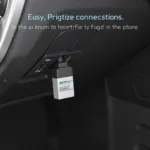The OBD2 release date is a significant milestone in automotive history. Understanding its implementation and evolution is crucial for both car owners and professionals in the automotive industry. This article delves deep into the history of OBD2, exploring its origins, development, and the impact it has had on vehicle diagnostics and repairs.
The rollout of OBD2, or On-Board Diagnostics II, wasn’t a single event but a phased process driven by both legislative mandates and technological advancements. While the conceptual groundwork for standardized vehicle diagnostics began earlier, the actual OBD2 release date that most people refer to is tied to the 1996 model year in the United States. This was when all new cars and light trucks sold in the US were required to be OBD2 compliant. This mandate marked a pivotal shift in the automotive landscape, revolutionizing how we diagnose and address vehicle issues.
It’s important to note that the OBD2 release date varied slightly for different vehicle classes. While 1996 was the year for cars and light trucks, other vehicles followed suit later. This staggered implementation allowed manufacturers time to adapt to the new regulations and integrate the necessary technology. This also means that some vehicles manufactured before 1996 might have some level of OBD compliance, though not necessarily the full OBD2 standard. You can find information about when OBD2 came out for specific car models using our resources. For those interested in enhancing their diagnostic capabilities, check out the Ancel FX6000 Professional Full System Deluxe OBD2 Programming.
What Prompted the Need for OBD2?
The primary driver behind OBD2’s development was the growing concern over vehicle emissions and their impact on air quality. Prior to OBD2, diagnostic systems were manufacturer-specific, making it difficult for technicians outside of dealerships to access and interpret diagnostic data. This lack of standardization also hindered efforts to effectively monitor and control vehicle emissions. OBD2 aimed to solve these issues by creating a universal standard for accessing diagnostic information.
By standardizing the diagnostic interface and data protocols, OBD2 paved the way for more efficient emissions testing and repair. It also empowered independent repair shops and car owners with the ability to diagnose and fix emissions-related problems, fostering a more competitive and transparent automotive repair industry.
Unraveling the Different OBD2 Protocols
Even though OBD2 is considered a “universal” standard, it comprises several communication protocols. These protocols define how the scan tool communicates with the vehicle’s computer. Understanding these protocols can be particularly helpful when choosing an [OBD2 automotive PC scan tool demo download]. Common protocols include ISO 9141-2, ISO 14230-4 (KWP2000), SAE J1850 VPW, SAE J1850 PWM, and CAN (Controller Area Network). While most OBD2 scanners support all protocols, it’s essential to ensure compatibility, especially if you’re working with older vehicles.
OBD2’s Impact on the Automotive Landscape
The introduction of OBD2 significantly altered the automotive repair landscape. Independent repair shops gained access to the same diagnostic information as dealerships, leveling the playing field and promoting competition. This also empowered car owners to take a more active role in understanding and maintaining their vehicles. Resources like the [Thinkcar TKTPS20 OBD2 Scanner Tablet Professional Code Reader Diagnostic Tool] further empower both professionals and enthusiasts.
Beyond Emissions: OBD2’s Expanding Role
While emissions control was the initial catalyst for OBD2, its scope has expanded significantly over the years. OBD2 now provides access to a wealth of information beyond emissions data, including engine performance parameters, transmission data, ABS information, and more. This expansive data access has become indispensable for modern vehicle diagnostics and repair, aiding in troubleshooting a wide array of issues. You might even be interested in exploring advanced functionalities like [OBD2 Link MX software firmware].
The Future of OBD: Looking Ahead
As vehicles become increasingly complex and interconnected, the future of OBD systems promises even more advanced diagnostic capabilities. With the rise of electric vehicles and autonomous driving technology, the role of OBD systems is evolving to encompass new data streams and functionalities. We can expect to see more sophisticated diagnostic tools and software, enabling even more precise and efficient vehicle maintenance and repair.
Conclusion
The OBD2 release date marked a watershed moment for the automotive industry. From its initial focus on emissions control, OBD2 has evolved into a crucial component of modern vehicle diagnostics, empowering car owners and professionals alike. As vehicle technology continues to advance, OBD systems will undoubtedly play an even more critical role in ensuring vehicle safety, performance, and efficiency. What year did OBD2 come out for your specific vehicle? Understanding this history can help you appreciate the power and potential of this essential technology.
FAQ
- What is the OBD2 release date for cars in the US? 1996 for cars and light trucks.
- What does OBD2 stand for? On-Board Diagnostics II.
- Why was OBD2 implemented? Primarily to control and monitor vehicle emissions.
- What are the different OBD2 protocols? ISO 9141-2, ISO 14230-4 (KWP2000), SAE J1850 VPW, SAE J1850 PWM, and CAN.
- What information can I get from OBD2? Emissions data, engine performance parameters, transmission data, ABS information, and more.
- How has OBD2 impacted the automotive industry? It has standardized diagnostics, empowered independent repair shops, and provided car owners with more control over their vehicle maintenance.
- What is the future of OBD systems? They will continue to evolve with advancements in vehicle technology, encompassing new data streams and functionalities for electric and autonomous vehicles.
For further assistance, please contact us via WhatsApp: +1(641)206-8880, Email: [email protected] or visit us at 789 Elm Street, San Francisco, CA 94102, USA. We offer 24/7 customer support.
